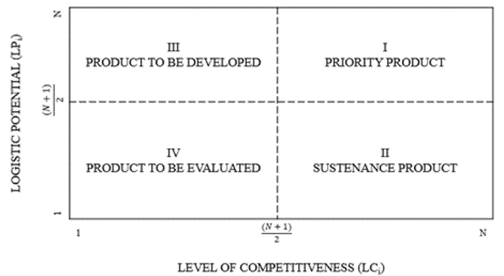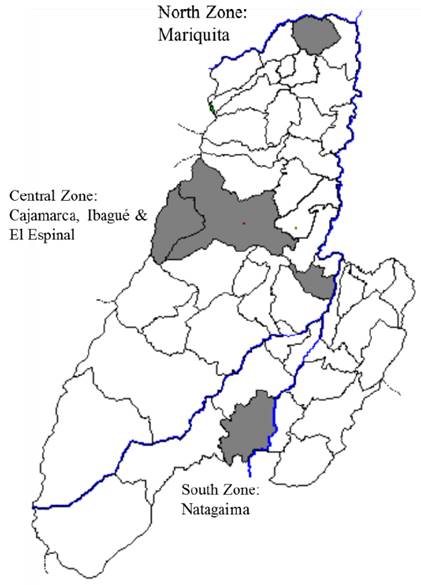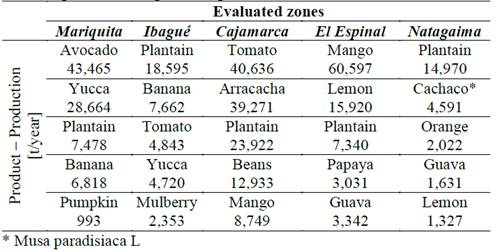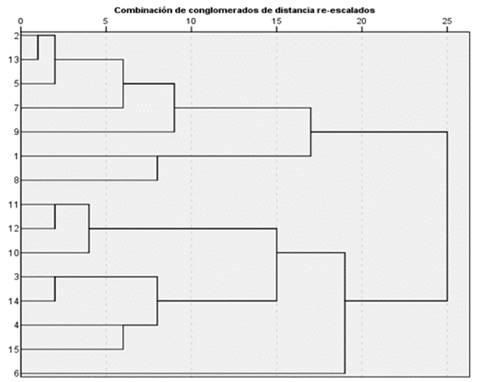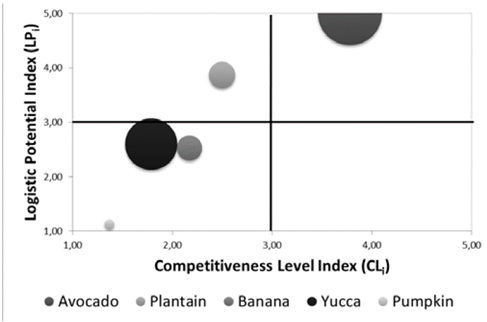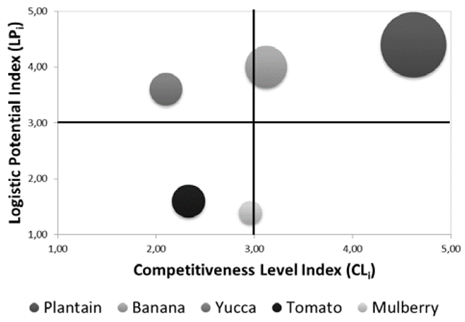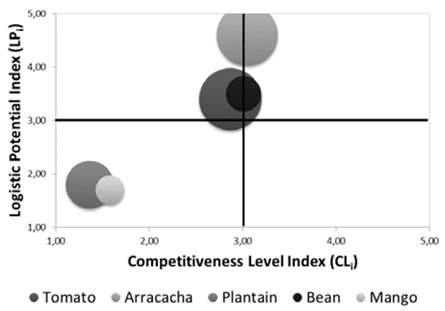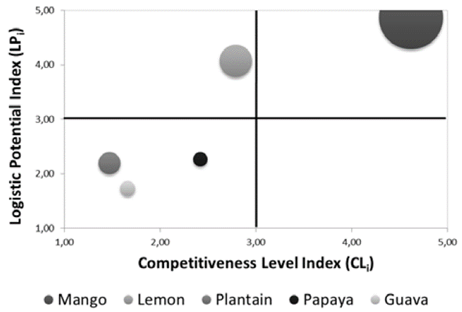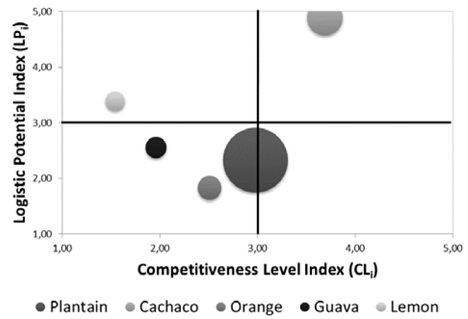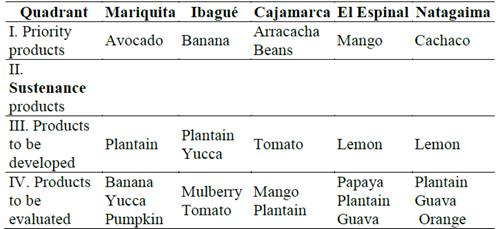1. Introduction
Direct contributions from agricultural and livestock sectors (crops, cattle raising, forestry, and fishing) in the development of the economy are reflected by their participation in the total GDP, their monetary earnings, and their important role in the use of workforce [1-3]. Moreover, agriculture represents a significant fraction of the economic activity in the developed world, with 25% of the added value coming from this sector [3,4]. Thereby, it seems reasonable that growth of agricultural productivity and management of food systems have significant effects upon economic variables [5] and on the life quality of the people [6,7].
Agricultural sector continues to play a fundamental role for development, especially in low-income countries, where this sector bears relevance, both in terms of added income as in the workforce in rural zones [8]. Particularly, the horticultural and fruit sector has been the food sector with the greatest growth in the world, evidencing the need to expand and identify adequate technological solutions, innovate in market agreements, link small farmers with the market to ensure efficient supply systems [9].
The importance of agriculture in the economic development of countries shown in the 2008 report on global development: Agriculture for Development [4] and Agriculture at the Crossroads [10] has, to a large extent, renovated interests for issues of the sector.
Although the agricultural economy has a proud tradition of developing practical tools that can quantify earnings and losses due to changes in policies or programs, as stated by [11]. It is evidenced that the formation of associations for the development of agricultural innovation in Latin America is often achieved without clear perceptions of the costs involved in the benefits that will be obtained. As a result, decision-making to prioritize resources and products becomes a challenge for local governments within the agricultural sector.
It is well-known that applying multi-criteria and hierarchical analysis techniques have become into useful tools for the decision-making process in any setting [12,13]. Globally, multi-criteria analysis techniques within the agricultural sector have focused on the analysis of risk aversion among producers, productivity improvement, decision-making, and the implications in water management in agricultural irrigation systems [14-17].
Multiple attribute assessment, combined with the analytical hierarchical process (AHP) have been used to evaluate optimal locations of new agricultural food warehouses, selection and adoption of products to cultivate, land preservation, and management of wetlands, among others [18-21]. On the other hand, in Colombia, this type of work has been developed to identify governmental difficulties for economic development, to evaluate of environmental impact, to locate of facilities, and to select of power generation systems to improve life quality of life in rural zones [22-25].
Regarding hierarchy products, several matrix models exist [26-31] that allow to classify them according to a set of criteria to establish priorities in the distribution of resources. In Latin America, countries, such as Argentina, Brazil, Mexico, Colombia, Venezuela, and Chile have conducted research aimed at characterizing the forest and agro-industrial subsectors to help decision-makers on how to direct financial resources to increase productivity. These studies have been based on two factors: socioeconomic importance and competitiveness, recommended by the method from the International Service for National Agricultural Research (ISNAR) and adapted to the specific conditions of each region [32-35]. However, as it relates to the ranking of agricultural products, the aforementioned studies have not considered the feasibility of the product for its national and international commercialization, the ease of distribution, and the feasibility of industrialization; variables that are not directly linked to productivity, which are fundamental to increase the competitiveness of the chain.
In recent years in Colombia, a fund for science and technology has been implemented with resources coming from the exploitation of natural resources (royalties). This fund seeks to fund projects in science, technology, and innovation (ST+i) aimed to applied research programs and programmed to guarantee an impact upon the production sector. Given the need to develop strategies that allow to improve the agricultural sector in the state Tolima, Colombia [36,37], the state government has approved a project to design and implement a logistics model, as the basis for the integration of value on the horticultural and fruit chains. During the first phase of the project, the researchers are faced with the decision to determine which horticultural and fruit chains need to be intervened, so that logistics strategies can be implemented. The aim of this paper is to propose a methodology based on multi-criteria techniques for decision- making, bearing in mind quantitative and qualitative criteria that allow to prioritize the agricultural products.
2. Prioritization methodology
The principal methodological aspects considered during this first phase of the Project are simplified in the following four steps:
Step 1. Selection of zones and products to evaluate by zone. To select the zones in the region, the region’s geographic distribution must be considered, along with its agricultural tradition and presence of the crops object of study. Also, to select the agricultural products to prioritize it is necessary to review reports on statistical production to establish the region’s most representative products.
Step 2. Quantitative analysis. After preselecting the products (variable i) from each zone, it must be establish the quantitative criteria (variable j) to be analyzed in each product according to the Planning method of technological development in agro-industrial chains from ISNAR [34]. Thereafter, information is gathered on the criteria in each zone and per product (Xij). Upon obtaining the information, it is normalized and the level of competitiveness index (LCi) is calculated per product, which is within a range from 1 to N (N = Number of products to prioritize). To calculate the LCi, eq. (1)-(2) were used:
Step 3. Qualitative analysis. This analysis applies the DELPHI method [38], which suggests gathering a number (variable k) of no less than 10 experts on the topic of analysis, who according to their knowledge and expertise will score the logistic potential of the products (variable i) preselected from each zone in the previous step, bearing in mind the viability of each product for its national and international commercialization, ease of transportation and handling, possibility to obtain derived products, and its feasibility for industrialization. Additionally, this index is evaluated within a range from (1) to (N), with (N) being the best score, with the excluding valuation restriction (without repetitions). With the assessments obtained in each round of the method of experts, a descriptive statistical analysis must be performed to evaluate the experts’ consensus from the calculation of Kendall’s level of concordance (W) [39,40]. It is necessary to validate the level of concordance by applying the chi-squared (χ2) test at a 95% confidence interval (α=5%) from the evaluation of the following hypotheses:
Ho: W=0; no concordance exists in responses of experts
Ho: W>0; concordance exists in responses of experts
In case of not reaching a concordance level above 0.70 with the experts, a new valuation round must be carried out. Evaluators must are given the statistical results from the previous round. It is convenient to perform no more than three rounds per zone. If the concordance coefficient calculated during the third round is below the minimum recommended (W < 0.70), an alternative would be to perform the cluster analysis by grouping the responses via hierarchical clustering to identify atypical data. Furthermore, recognize the experts that converge in their scores. The logistic potential index (LPi) of each product is calculated based on the scores by the experts. To calculate the LPi, eq. (3) was used:
Step 4. Prioritizing of products. In order to prioritize the products, data on the indices calculated (LCi) and (LPi) must be consolidated in the prioritization matrix and then these results are mapped on an XY plane (1≤X≤N; 1≤Y≤N). The graphic must be included as a third variable of annual production analysis of each product, represented by the diameter of the bubble from the figure. To facilitate interpretation of the graphic, the prioritizing matrix is divided into four quadrants limited by the mean values of each indicator, as shown in Fig. 1.
3. Results
3.1. Selection of zones and products to evaluate per zone
The zones (epicenters) selected to carry out the work are geographically distributed throughout the state of Tolima. It is recognized for their agricultural tradition and its large areas cultivated with fruits and vegetables. Fig. 2 shows the distribution of the zones selected within the State.
After reviewing the statistical figures for the State in the horticultural and fruit sector available from the State Secretary of Agriculture [41-44], five products were preselected with the highest production in each of the zones selected. Results of the pre-selection are shown in Table 1.
3.2. Quantitative analysis
Taking as base the variables established within the agricultural and livestock research policies developed by ISNAR [34], the following criteria are shown in Table 2
Information from each of the criteria was collected per product and zone, thus, obtaining the necessary information to calculate the product’s competitiveness index LCi (eq. 1). Table 3 shows, as an example, the information obtained through criterion for each product in the Mariquita zone. Table 4 shows the competitiveness indices obtained for each product in each of the five zones analyzed. It can be noted that LCi is not directly related to annual production values (Table 1).
Table 3 Information of the quantitative criteria evaluated for the Mariquita zone

Source: Corporación Colombiana Internacional (CCI) - national agricultural base 2007-2012
3.3. Qualitative analysis
After applying the DELPHI method with the participation of 15 experts, Table 5 shows Kendall’s level of concordance obtained in the responses from experts, the p value for the chi squared test, and the number of rounds conducted in each of evaluated zones.
Table 5 Values for Kendall’s coefficient in each of the rounds conducted per evaluated zone

Source: The authors
According to the methodology proposed, in zones where the minimum desired level of concordance was not achieved, Ibagué, Cajamarca, and Natagaima, cluster analysis was performed [45] grouping by conglomerate the responses by the experts on the third round and discarding atypical valuations. Fig. 3 shows, as an example, the dendogram carried out through hierarchical cluster analysis in Ibagué zone.
With results from the hierarchical classifications, the number of expert responses was determined to analyze the third round. With the number of adjusted valuations, Kendall’s concordance coefficient was again calculated (Table 6).
For the Cajamarca and Natagaima zones, it was decided to work with a concordance coefficient below the recommended value (0.75), given that the values obtained gathered the responses of a significant number of experts and these were significantly higher than those obtained during the third round.
Upon defining the concordance levels and the number of experts (K) in each zone, LPi was calculated through eq. 2. Results are shown in Table 7.
Table 7 Values of logistic potential indices of each product evaluated in each of the epicenters selected

Source: The authors
It can be noted that in most of the zones the product with the highest logistic potential index is directly related to the product with the highest production volume. However, this behavior is not noted in the Natagaima zone, which is partly explained because the Cachaco leaf has commercial potential as wrapping material for typical foods [46,47], which is not reflected in the results of production volumes (Table 1).
3.4. Prioritizing of products
The results obtained for the competitiveness level index (LCi) and logistic potential index (LPi) for each of the horticultural and fruit products from the five zones studied were located on the product prioritizing matrix. The results obtained in each of the zones are shown in Fig. 4-8.
According to Figs. 4-5, in the Mariquita and El Espinal zones, the indicators of the level of competitiveness and logistic potential show a direct relationship, clearly evidencing the priority products in the zone. This behavior is related to the results found through the method of experts, which yielded high concordance coefficients as the first rounds, and its final value was above the accepted minimum. Additionally, it can be seen that in the Mariquita zone, yucca in spite of having the second production volume, was placed in the quadrant of products with low competitiveness level and low logistic potential (products to be evaluated).
Also, the Ibagué, Natagaima, and Cajamarca zones do not show a defined tendency in the prioritizing matrix; this behavior agrees with that reflected in the results of the method of experts. The prioritizing matrix in the Ibagué zone placed plantains in the quadrant of products to be developed, suggesting their selection for productivity improvement programs of this chain. It is also important to highlight that in the Ibagué and Cajamarca zones, no product was found clearly placed in the first quadrant (priority products); this was due in part to the lack of products with outstanding competitive levels (LCi) in these zones.
Table 8 summarizes the prioritizing of products and the location of the quadrant within the prioritizing matrix per zone
4. Conclusions
The proposed methodology allows to prioritize products and serves as support in decision-making processes to implement logistic development plans in the agricultural sector. By dividing the prioritizing matrix into four quadrants, it allows to classify the production chains in the study zone, placing them into four categories defined as: ‘Priority, ‘To be developed’, ‘Sustenance’ and ‘To be evaluated’, classification that allows to define the importance of the chain in evaluated zone.
Also, the methodology proposed establishes the concept and opinion of experts from the sector, as well as indices of agricultural production of the products, combining quantitative and qualitative criteria, which leads to a broader and more reliable analysis for the decision-making process and allocation of resources.
For the conducted case study, no products were found in the sustenance quadrant; this may be because most of the products analyzed have a competitiveness level below the mean and those products above this level have high logistic potential, placing them in priority products. Additionally, in zones where the Kendall concordance coefficient yielded high values as of the first rounds, the values of the indices of competitiveness and logistic potential show direct relation. Lastly, it is worth highlighting that although some products have a significant production level, after applying the prioritizing methodology these were placed in the lowest quadrant (products to evaluate), which indicates that a high production volume does not ensure a relevant position in logistic and competitive terms (priority products).
















